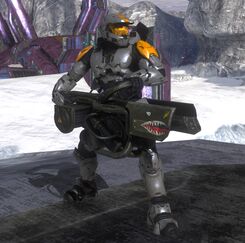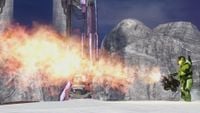M7057/Defoliant Projector
From Halopedia, the Halo wiki
- "It takes a certain kind'a lunatic to use a flamethrower…"
- — Anonymous E2-BAG/1/7 serviceman
The M7057/Defoliant Projector[1], more commonly known as the M7057 Flamethrower, is a United Nations Space Command ground weapon.
Description
The M7057/DP is a standard chemical flamethrower, which projects and ignites a stream of a volatile, semi-liquid fuel. Flamethrowers are cumbersome and relatively difficult to use (psychologically as well as mechanically, especially when the fuel is located on the weapon itself). It appeared in the multiplayer of Halo PC and Halo 3. The Halo 3 version of the M7057 varies slightly from its first appearance in Halo PC, being roughly two times larger (and about twice as much fuel) with a shorter and wider nozzle (which means a wider, deadlier spray). It also poses a threat to vehicles, a full three-second burst being able to destroy a Warthog. The flamethrower is extremely powerful in Halo 3 and can kill it's target in less than two seconds as seen at the Omegathon.[1]

However, the flamethrower's power comes at a cost: it can only sustain fire for about three seconds before it overheats. The M7057 is in the Support Weapons category, like the Missile Pod, meaning wielders use the weapon in a third-person perspective and at a slower movement rate, and must drop the weapon to melee and cannot use grenades or equipment. The weapon is resisted by the bubble shield, "washing over the shield."
Referring to the M7057/DP as a weapon is a bit of a misnomer as the "DP" in its nomenclature indicate that it is a defoliant projector—to be used to rapidly clear away heavy foliage for in-theater construction projects and to destroy new or persistent growth from emplaced and/or hardened military assets. It is a great weapon for exterminating clumps of enemies.
Combat
Advantages
In Halo 3, the Flamethrower is far more powerful, laying waste to any opponent in close quarters, and can be used strategically to put flame in front of entry ways as a denial of entry, or to shoot it while running backwards around a corner (giving you the ability to damage them but denying them a direct line of sight to damage you). It also has a large fuel supply unlike it's Halo PC counterpart. It also kills majority of Flood forms nearly instantly. Combat forms will die but they continue to move for a few seconds and will come after you while on fire, which depletes your shields. This makes it more strategically useful to attack with a more conventional weapon.
Disadvantages
Several things counterbalance the Halo 1 PC Flamethrower's high damage rate. First, the reload time is far to slow compared to other weapons, and is subject to overheating if you fire the weapon too long. Second, ammunition for the Flamethrower is often unavailable. Third, the Flamethrower can damage its own user if one walks into the trail of flames left behind by the weapon. This lets the enemy run away while stopping the user from giving chase, it also has splash damage, which in very close range firing, it can harm the opponent and player.
If used at a distance, the Flamethrower takes longer to kill an enemy and might not even damage them. Finally, the Flamethrower is very rare. There are only one or two of them per map. Moving also affects the damage put out by the flamethrower. If you move forward while firing, the flame will be more damaging, but when moving backwards, the flame does about the same as an Assault rifle. Therefore, while using this weapon in combat, your movement options are limited.
In Halo 3 you cannot refuel the flamethrower, and you move slower and cannot melee, throw grenades or use equipment without having to drop it first. Also, if any enemies who are on fire walk into you, or you walk over a corpse having just been incinerated, you take damage. Also, the flamethrower is only a threat in confined space; in open spaces, it's very hard to directly harm your opponent, and your opponent will keep firing until the flame consume them.
Role in Campaign
With the Flamethrower's campaign introduction in Halo 3, it has become one indisputably best anti-Flood weapons. The hardest type of Flood to fight, the Pure Forms, will die nearly instantly upon lighting on fire, and destroy any infection form that runs over the flames.
Though still highly effective against combat forms, they still live for some time while on fire, which can produce some awkward moments of avoiding their charging, flaming, bodies. A good attribute is that it can begin killing multiple combat forms at once, with the ones on fire possibly lighting other ones on fire. Once they die, their bodies are consumed by the fire and will not be able to be resurrected by infection forms. In fact, any infection form that runs towards the body will also be consumed by flame. It can also be used to destroy a pile of combat forms so they won't come back if an infection form finds them.
This also seems to be the only support weapon in Halo 3 that wasn't originally turret-mounted.
Multiplayer Role
The Flamethrower is best used in close quarters combat. The trail of flame can act as a temporary smokescreen to blind snipers with. It is especially effective if used to retreat by running backwards away from an enemy to leave a trail of flame, deterring would-be pursuers from giving chase to a wall of fire, use caution because the Flamethrowers damage is reduced when running backwards. It is incredibly useful for close quarters defense, but should not be used in any open areas. Small room flag defense is highly recommended.
It is effective as a denial of area weapon, you can put the flames in doorways or on flags to discourage anyone from crossing that area, and damaging those that do (possibly even catching on fire and killing unshielded opponents).
As a slayer weapon, it is recommended to use it to surprise people entering enclosed spaces, it is very lethal up close. You can shoot the flames around a corner as you run backwards around a corner, and any opponent dumb enough to pursue will be roasted by flames but unable to get a line of sight to get you themselves.
Sometimes, players even await near the some strategic points, with active camouflages, like where opponents alight once fired from the Man Cannon, where they will overfry them by surprise.
Most types of equipment can often be at your advantage at escaping the flames, like deploying a Radar Jammer to confuse the enemy if he/she can't see you, and since you'll be moving about, the enemy can't identify you from the "Fake" red dots on his radar. Deploying a Power Drainer will cause the wielder of the Flamethrower to cease fire temporary to avoid having his/her's shields to be drained if smart enough, but if the wielder is somewhat dumb enough to carry on firing, the power drainer will ultimately let the wielder be prone to most any type of weaponry fire.
Tactics
- Guarding the bomb carrier in Assault
- Guarding your VIP
- Defending the hill in King of the Hill
- Defending the flag in Capture the Flag
UNSC Remarks
- "Foxtrots die pretty quick once you put the fire to 'em. We ought 'a burn 'em all. Low-life bastards. Burn all those low-life alien foxtrots."
- "Gotta get too close for it to be any use offensively—if you're gonna use it as a weapon best to use it in a defensive role—fill up passages and weak-points in your perimeter with fire."
- "Makes short work of weeds and thickets—but I wouldn't carry one into combat. Not on your life."
- "I can see where it would be real effective in ousting dug in troops, but you aren't gonna be making any friends using it that way."
- "I don't see why carrying around a big can of super-flammable stuff right next to my *** is such a good idea."
- "You know those things ship with a cart, right? You aren't expected to carry them anywhere… they are not a weapon that you use on people… not even on alien people."
Influences
The Defoliant Projector Flamethrower was inspired by a similar flamethrower from the Marathon series. The shark-like decal on it is borrowed from the game as well. In Marathon, however, it is featured on the rocket launcher. The Defoliant Projector's number, 7057, is a alpha-numeric callback to the Weapon from Marathon's name, the TOZT. There is also a possibility it was influenced by the flamethrower from the Aliens movies.
Trivia
- The Flamethrower's number designation, 7057, can be translated from "1337speak", and it means the TOST. It may be a reference to the Marathon Flame Thrower, which was named the TOZT-7, or it simply relates to the Flamethrower's function, to toast things.
- The Halo 3 flamethrower bears a resemblance to the original flamethrower from Halo PC. However the main difference is it's fuel tank, and the flame projector.
- In the cut scene of the level Keyes, where the Master Chief retrieves Captain Keyes' neural implants, the Master Chief was meant to burn Keyes' skull out of the Brain Form and retrieve the implants. Unfortunately, due to time constraints, the Flamethrower was removed. Although the burning of the skull was said to be too gruesome to be put into the game. [2]
- It is able to spawn a flamethrower by devmode in the level Keyes, if grunts caught fire, they would have a reaction to being stuck. If you fire at an elite, they will jump out of the way just like how they dodge a grenade.
- The targeting reticle of the flamethrower is actually taken from the hypothetical "gravity rifle" in Halo: Combat Evolved, however, the gravity rifle was removed from the game.
- In the Videogame 'Shadowrun', the weapon 'Mini-gun' has a shark decal much like the flamethrower from Halo: Combat Evolved and Halo 3.
